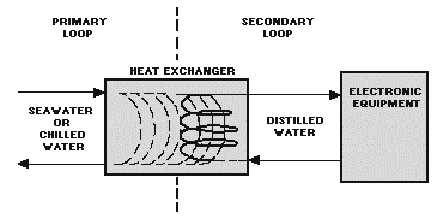4-21
Distilled water is one of the best mediums for cooling high-power components, and, in many cases,
the only medium that may be used.
For a distilled-water-cooling system to operate satisfactorily, the temperature, quantity, purity, flow,
and pressure of the water must be controlled. This control is provided by various valves, regulators,
sensors, meters, and instruments that measure the necessary characteristics and provide the required
regulation.
Liquid-cooling systems consist of a sea water or a chilled (fresh) water section that cools the distilled
water circulating through the electronic equipment. The main components of cooling systems are piping,
valves, regulators, heat exchangers, strainers, circulating pumps, expansion tanks, gages, and
demineralizers. Other specialized components are sometimes necessary to monitor cooling water to the
electronic equipment.
A typical liquid-cooling system is composed of a PRIMARY LOOP and a SECONDARY LOOP
(figure 4-16). The primary loop provides the initial source of cooling water and the secondary loop
transfers the heat load from the electronic equipment to the primary loop. The source of cooling water for
the primary loop is either sea water from a sea water supply or chilled water from the ship's air-
conditioning plant. The cooling water used in the secondary loop is distilled water. Ultrapure systems are
maintained by a demineralizer and use double-distilled water obtained through the Navy Supply System.
Figure 4-16.—Liquid cooling system block diagram.
Additional information about liquid cooling systems can be found in Basic Liquid Cooling Systems
for Shipboard Electronic Equipment Technician's Handbook, NAVSEA 0948-LP-122-8010.
Q19. What type of cooling is used to control ambient room temperature?
Q20. A typical liquid-cooling system is composed of what loops?
Q21. What loop of a cooling system is often supplied by sea water?

